The Galaxies

You Can See These Notes :
* What Is The Galaxies ? *
The galaxies are spiral shaped clusters of stars, meteoroids, planets and many other space bodies similar to the Milky Way, the galaxy that houses the solar system where we are.
The Discovery of Galaxies
By the eighteenth century many astronomers have observed, among the stars, the presence of extensive and diffuse bodies, which they called "nebulae". Today we know that different types of objects were grouped under this term, most belonging to our own galaxy: gas clouds illuminated by stars within them, peel gas ejected by stars in the final stages of stellar evolution, star clusters. But some nebulae - spiral nebulae - were individual galaxies like our Milky Way.
Immanuel Kant (1724-1804), the great German philosopher, influenced by astronomer Thomas Wright (1711-1786), was the first to propose, around 1755, that some nebulae could be fully comparable to our Galaxy star systems. Citing Kant: "[A] analogy [of nebulae] with the star system in which we live ... is in perfect agreement with the concept that these objects are simply elliptic universes [island], in other words, Milky Ways ... ". This idea became known as the "hypothesis of island universes." However, the cosmological speculations of Kant were not well accepted at the time, so that the nature of the nebulae remained a subject of controversy.
Until , about hazy had been cataloged and described. Some had been correctly identified as star clusters, gaseous nebulae and other such. The majority, however, remained with unexplained nature.
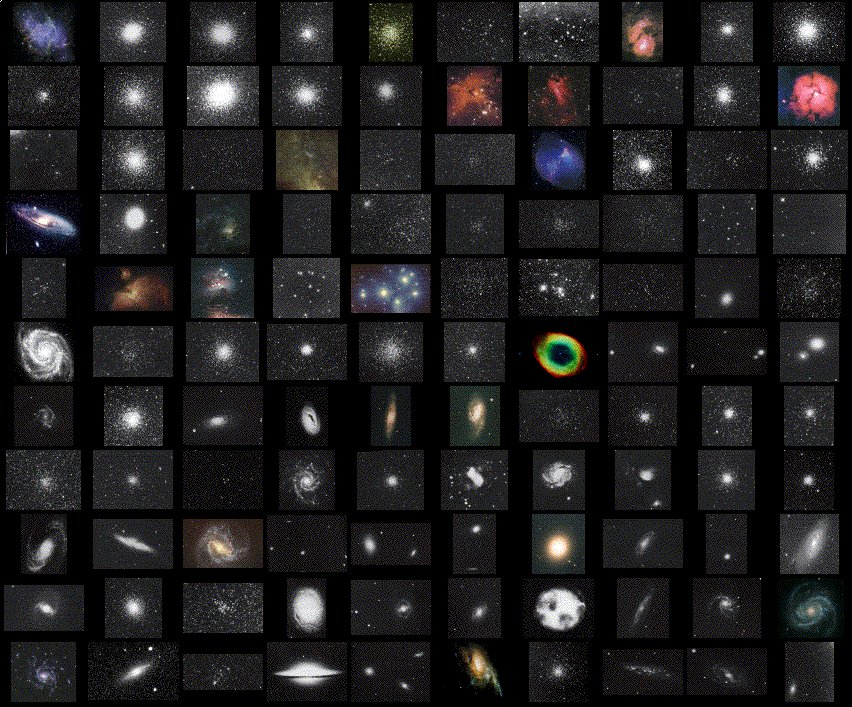
The biggest problem is that the distance was not known to them, so it was not known whether they belong to our galaxy or not.
Two of the biggest players in this controversy were Harlow Shapley , the Mount Wilson Observatory, and Heber Doust Curtis , of the Lick Observatory, both in the United States. Shapley argued that spiral nebulae were objects within our galaxy and Curtis argued the opposite idea, that they were extragalactic objects. The discussion culminated in a famous debate in April , opposite the National Academy of Sciences. But the debate did not solve the issue. HubbleSomente Edwin Powell Hubble in gave the final to consider the "spiral nebulae" as independent galaxies, to identify a Cepheid variable in the "Nebula" Andromeda evidence.

From the known relationship between period and luminosity of the Cepheids in our Galaxy, and the apparent brightness of the Cepheids in Andromeda, Hubble can calculate the distance between this and the Milky Way, obtaining a value of million light years. This Andromeda stood just beyond the limits of our galaxy, which has thousand light years in diameter. It was thus proved that Andromeda was a separate star system.
A Cepheid in the galaxy IC , (mM) = , observed by the Hubble Space Telescope
Morphological classification of galaxies
Galaxies have been historically categorized according to their apparent shape, usually referred to as their visual morphology. A common form is the elliptical galaxy, which has a profile of brightness in an elliptical shape. Spiral galaxies are disk-shaped, with curved arms. Those with irregular or unusual shapes are known as irregular galaxies and typically originate from disruption by the gravitational pull of neighboring galaxies. These interactions between galaxies, which may result in the end its junction sometimes induce significantly increased incidents of star formation leading to starburst galaxies. Smaller galaxies that lack a coherent structure are referred to as irregular galaxies.
- Elliptical Galaxies
Elliptical galaxies are a type of galaxy which have spherical shape and have a spiral shaped structure. The vast majority of these galaxies have little gas, a little dust and a few young stars. A more explicit form they closely resemble the core and halo of spiral galaxies. Some are well elongated and flattened other well if viewed from Earth. Although it may seem simple elliptical galaxies believed to be the result of complex union of two or more spiral galaxies. Elliptical galaxies vary widely in size, some are super-giant with a diameter of millions of light years, however some are dwarfs, having only a few thousand light years in diameter. The giant ellipticals are rare and exotic, as the dwarf ellipticals are the most common type of galaxies. Given these huge differences in size, elliptical galaxies were divided into morphological classes:
 ~
~
*Spiral Galaxies
Spiral galaxies are so named because of their morphology, as viewed from the "top" show a clear spiral structure around a nucleus. In censuses emerge as the most common type. Spiral galaxies are young and old stars, suggesting that not formed from another galaxy or older of an ancient collision between two galaxies. At the core there is a predominance of older stars and arms there is an increased activity of star formation. Thus, the nuclei of spiral galaxies have a more orange hue arms and a more blue hue. Spiral galaxies have diameters ranging from 20 thousand light-years to over 100 thousand light-years. It is estimated that their masses range from 10 billion to 10 billion times the mass of the Sun The Milky Way, where is the solar system, is a large and massive spiral galaxy.
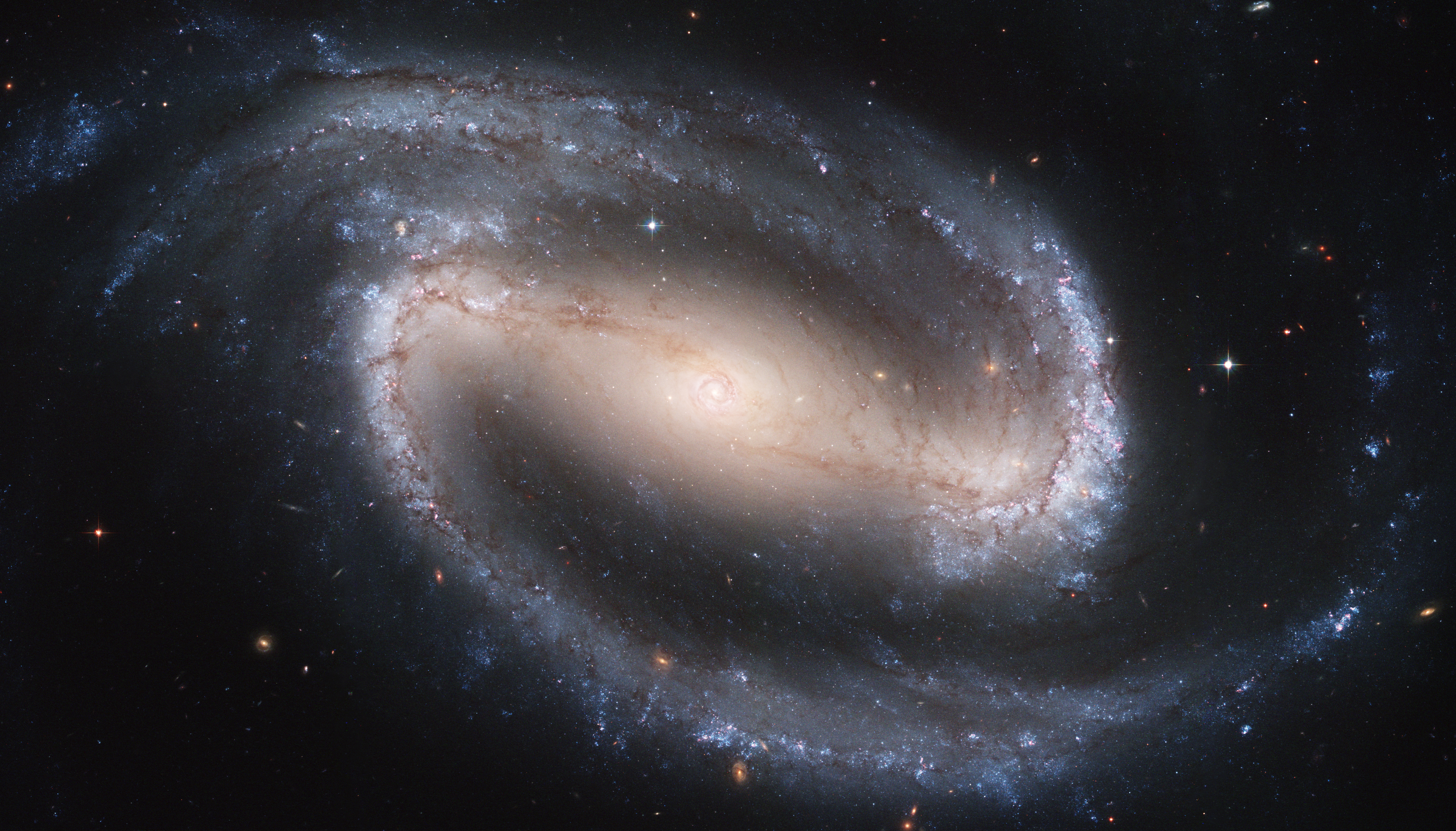
- Irregular Galaxies
Irregular galaxies are a type of galaxy that have a disordered or chaotic morphological structure, ie, have no spiral or elliptical shapes, but indefinite shape. Generally this type of galaxy has a lot of newborn stars and new stars continue to profilerar always in overdrive. Hardly irregular galaxies have large dimensions, and yet those of large size are usually the result of collisions between two galaxies. Some scientists believe that the typical irregular galaxies may be the first stage of evolution of an elliptical galaxy and a spiral galaxy.

Masses of Galaxies
As the mass of a star is its most important physical characteristic, also the mass in galaxies plays a crucial role not only in its evolution as individual systems, but in the evolution of the universe itself. For example, the amount of mass of galaxies depends on the density of visible matter in the universe.
The best way to measure the mass is from the velocities of stars due to the gravitational attraction between them. In elliptical galaxies, the measured speeds are average speeds because the movements of the stars in these systems have components of the same magnitude in the three directions, and all follow very elliptical orbits.
*Masses of Elliptical Galaxies
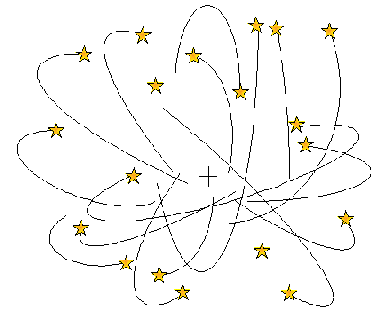 ~
~
The masses of elliptical galaxies can be determined from the Virial Theorem, which states that a stationary system (whose properties do not vary with time), the sum of the gravitational potential energy of the particles and double its kinetic energy is zero :
where is the gravitational potential energy and Is kinetic energy
We consider a galaxy as a stationary system (because it is neither contracting nor expanding), whose particles are the stars.
The kinetic energy of the stars in the galaxy can be written as:
where M is the total mass of the galaxy and v is the average velocity of the stars, measured by the broadening of the spectral lines .
The gravitational potential energy is :
where R is an average radius of the galaxy can be estimated from the distribution of light. Combining the above three equations we find that
Masses of Ellipticals =
This same method can also be used to calculate the masses of galaxy clusters, assuming that they are stationary. In this case, consider each galaxy as a particle system. The kinetic energy can be calculated by the displacement of spectral lines, and the gravitational potential energy by the mean separation of galaxies in the cluster.
*Masses of Spiral Galaxies
Spiral galaxies are largely confined to the plane of the stars of the disc, with nearly circular orbits and speeds depend on the distance to the center.
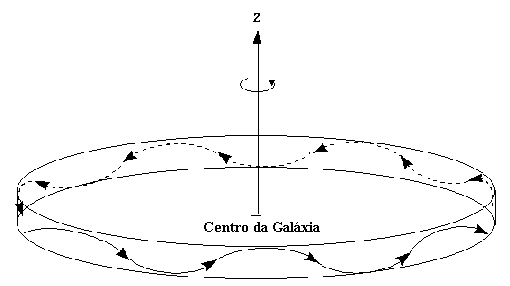
**In Photo "Centro da Galáxia" Is Center of the Galaxy
Rotation curve for the spiral galaxy NGC3198.

In spiral galaxies, in which the circular motion of the stars on the disk is dominant over the disordered motion of the stars in the bulge, the mass may be determined by the rotation rate (r) curve, which is a graph of rotation speed according galactocêntrica the distance. The rotational speed at each point are obtained by measuring the Doppler shift of the spectral lines. Assuming that most of the mass of the galaxy's internal bulge and, therefore, the rotational motion of the stars on the disk is determined by the mass of the bulge, this mass can determine by the gravitational force equal to the centrifugal force, in the same manner as determine the mass of our Galaxy.

Calling the internal mass to the radius , We have :

In many parts of outer coils, the velocity no longer depends on , remains constant, so that the larger the radius , the largest inner mass to it. As the outer parts of galaxies are very weak, from a certain value of the brightness value no longer increases, but according to the curve of rotation of mass continues to grow. This means that a large part of the mass of galaxies should not be luminous, and is known as the problem of dark mass.
Collisions between galaxies
Galaxies clusters are relatively close to each other, that is, separations between them are not large compared with their sizes (the spacing between galaxies is only of the order of one hundred times its size while the average distance between stars is the porder of million solar diameters. this probably means that these galaxies are a frequent interactions with each other.

In the existing catalogs of peculiar galaxies there are many examples of pairs of galaxies with strange appearances which seem to be interacting with one another. We understand many of these cases in terms of the gravitational tidal effects, which tend to stretch objects in the direction of approach. The effects of tides between pairs of galaxies are close to each other were studied by Alar and Juri Toomre. They pointed out three fundamental properties interactions per trip:
: The tidal force is proportional to the inverse cube of the separation between galaxies
: The tidal forces on an object tends to lengthen it; Thus, the tidal bulges are formed on the near side and the far side of each other in relation to the galaxy
: Disturbed galaxies generally revolved before the tide against the posterior distribution of its material should therefore reflect the conservation of its angular momentum.
As a first result, it is expected that an interaction between two galaxies tidal pull of matter toward each other. These "bridges" of matter actually form between the interacting galaxies, but also formed tails of matter coming out of each galaxy in the opposite direction to the other. Due to the rotation of galaxies, tails and bridges can take strange forms, especially if we take into account the fact that the orbital motions of galaxies are in a plane that forms an angle with any our line of sight. The Toomre brothers have managed to calculate models of interacting galaxies that mimic the appearance of several pairs of galaxies with strange shapes, actually seen in the sky.
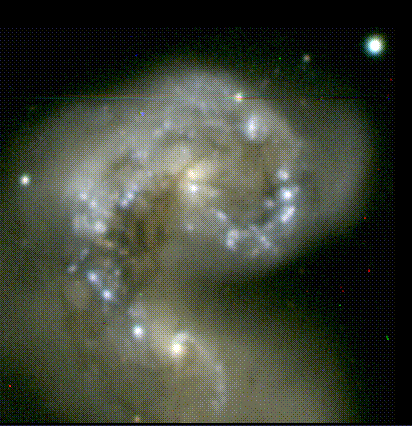 ~
~
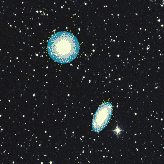
NGC 4038/9: a textbook example of colliding galaxies.

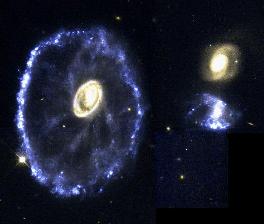
Model calculated by Alar Toomre for a frontal collision between two galaxies, forming a galaxy with ring, and a photo taken with the galaxy wheel Hubble Space Telescope.


, the brightest, and , and an interaction model of its formation, obtained by Min Yun, the National Radio Astronomy Observatory.
Merging of galaxies and galactic cannibalism
If galaxies collide with relatively low speed , they can avoid disruption by tide. The calculations show that some parts of galaxies can be forcibly colliding while the main bodies are converted into binary (or multiple ) systems with small orbits around one another. The newly formed binary system is encased in an envelope of stars and possibly interstellar matter , and may eventually merge into a single galaxy. This process is especially likely in collisions between members of a more massive cluster of galaxies , which tend to have relatively lower speeds . The merger can convert spiral galaxies in elliptical .
The term merger of galaxies is used in reference to the interaction between galaxies of similar sizes . When a very large galaxy interacts with another much smaller , the tidal forces from the larger galaxy may be so strong as to destroy the structure of the galaxy smaller pieces which are then merged into larger. Astronomers call this process of galactic cannibalism.
Recent observations show that giant elliptical galaxies , known as cD galaxies have peculiar properties , such as very large halos ( up to 3 million light years in diameter) , multiple cores , and locations in centers of clusters . These properties suggest that these galaxies formed by galactic cannibalism.
Often , the encounter between the galaxies is not strong enough to result in fusion. In a weaker interaction , both galaxies survive , but the tidal effect can arise tails of matter on one or both sides of the two galaxies. Many galaxies with strange appearances, which do not fall into either category Hubble , show evidence of recent interactions . Computer simulations show that its shape can be reproduced by tidal interaction in collisions . A recent result of computer simulations is the possibility that collisions can transform spiral galaxies into ellipticals : the interaction can withdraw gas , stars and dust of the two galaxies , turning them into an elliptical . The collision may also direct large amounts of gas to the center of the resulting elliptical , allowing the creation of a black hole
Here Ends the sequence Notes Universe! I hope you have some fun with these Notes and Learn Something!
Any recommendation to Create Other Notes. Please! Comment Below!
All the Best For All !
Easy Math Editor
This discussion board is a place to discuss our Daily Challenges and the math and science related to those challenges. Explanations are more than just a solution — they should explain the steps and thinking strategies that you used to obtain the solution. Comments should further the discussion of math and science.
When posting on Brilliant:
*italics*or_italics_**bold**or__bold__paragraph 1
paragraph 2
[example link](https://brilliant.org)> This is a quote# I indented these lines # 4 spaces, and now they show # up as a code block. print "hello world"\(...\)or\[...\]to ensure proper formatting.2 \times 32^{34}a_{i-1}\frac{2}{3}\sqrt{2}\sum_{i=1}^3\sin \theta\boxed{123}Comments
Ooh... Pretty colors on the pictures. :O
Hey Gabriel ! This note is good... But try to post them in parts...So,that it could be great...
Log in to reply
I agree. Gabriel might consider to make shorter notes yet still informative :)
@Gabriel Merces This is so amazing thanks keep it up.
Great work Gabriel
this is somethin to read
Your work should be really appreciated by all! ☺ so many new things to know
@Gabriel Merces it would be great and helpful too if you can create notes on black hole and dark energy. ..
Log in to reply
Here : Black Hole
Dark Energy
wht a gorgeous concept of explaining this.
Great work!:)
What is a radio galaxy?